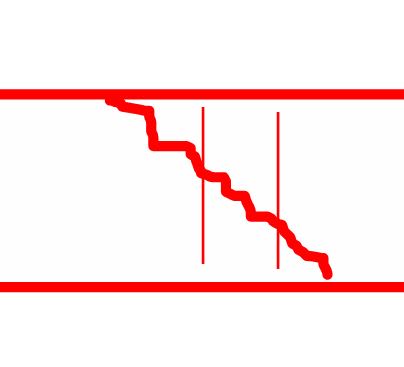Jacob-William
Structural
Hi all,
I'm doing some punching shear checks for a series of columns acting on a 1.0m base slab for a deep underground metro station.
The contribution of stirrups or links is given by S11.4.7.2 in ACI318-11(M), or equivalent 22.6.7.2 in ACI318-19(M) etc.
As the applied shear stress (vu) is taken around the critical perimeter (bo * d), and the concrete contribution to a slabs resistance (vc) is also around this critical perimeter, the shear stress that the stirrups or links must provide is also calculated over the critical area:
ɸvs = vu - ɸvc
ɸVs = ɸvs * (bo * d) {total shear force sitrrups or links needs to provide}
Therefore:
Total Area of Stirrups Required, Av = ɸVs / ɸfyt {where fyt is yield stress of stirrup or link)
Total Area of Stirrups Required, Av = [ɸvs * (bo * d)] / ɸfyt - {Eq. 1}
Up to this point this makes sense to me - and is almost the same as what is specified in the ACI code.
In order to get the above equation I have derived (Eq. 1) to what ACI specifies (Eq. 2) you have to multiply by (s/d), where s is the spacing of longitudinal reinforcement i.e. spacing of perimeter between stirrups or links perpendicular to face of column considered (see below):
Total Area of Stirrups Required, Av = [ɸvs * (bo * d) * s]/ [ɸfyt * d] = [ɸvs * bo * s]/ [ɸfyt] -{Eq. 2 - d terms cancel}
I can rationalize what the use of this factor is trying to do by accounting for the number of 'perimeters' within the critical area d/2 from the face of the column. I.e. if d/2 = 300mm and s = 150mm then you have 2 perimeters within d/2 and therefore you need half the reinforcement so a factor of 0.5 is applied to Av.
However this would require multiplying by a factor of s/0.5d and not a factor of s/d.
I am probably missing something obvious here as I usually design to Eurocodes and ACI is new to me -but I would appreciate if anyone could tell me why a factor of s/d is used instead of s/0.5d?
Thanks in advance!
I'm doing some punching shear checks for a series of columns acting on a 1.0m base slab for a deep underground metro station.
The contribution of stirrups or links is given by S11.4.7.2 in ACI318-11(M), or equivalent 22.6.7.2 in ACI318-19(M) etc.
As the applied shear stress (vu) is taken around the critical perimeter (bo * d), and the concrete contribution to a slabs resistance (vc) is also around this critical perimeter, the shear stress that the stirrups or links must provide is also calculated over the critical area:
ɸvs = vu - ɸvc
ɸVs = ɸvs * (bo * d) {total shear force sitrrups or links needs to provide}
Therefore:
Total Area of Stirrups Required, Av = ɸVs / ɸfyt {where fyt is yield stress of stirrup or link)
Total Area of Stirrups Required, Av = [ɸvs * (bo * d)] / ɸfyt - {Eq. 1}
Up to this point this makes sense to me - and is almost the same as what is specified in the ACI code.
In order to get the above equation I have derived (Eq. 1) to what ACI specifies (Eq. 2) you have to multiply by (s/d), where s is the spacing of longitudinal reinforcement i.e. spacing of perimeter between stirrups or links perpendicular to face of column considered (see below):
Total Area of Stirrups Required, Av = [ɸvs * (bo * d) * s]/ [ɸfyt * d] = [ɸvs * bo * s]/ [ɸfyt] -{Eq. 2 - d terms cancel}
I can rationalize what the use of this factor is trying to do by accounting for the number of 'perimeters' within the critical area d/2 from the face of the column. I.e. if d/2 = 300mm and s = 150mm then you have 2 perimeters within d/2 and therefore you need half the reinforcement so a factor of 0.5 is applied to Av.
However this would require multiplying by a factor of s/0.5d and not a factor of s/d.
I am probably missing something obvious here as I usually design to Eurocodes and ACI is new to me -but I would appreciate if anyone could tell me why a factor of s/d is used instead of s/0.5d?
Thanks in advance!

